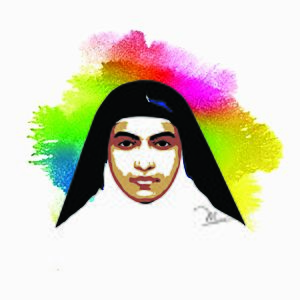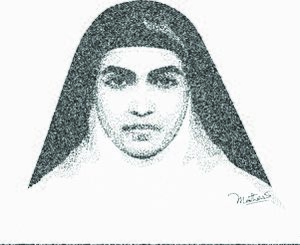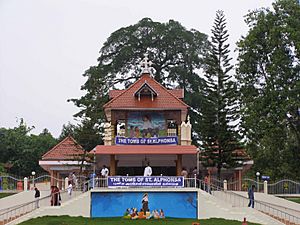Alphonsa of the Immaculate Conception facts for kids
Quick facts for kids Saint/ MarthAlphonsa Muttathupadathu F.C.C |
|
|---|---|

Saint Alphonsa Art Painting
|
|
| Born | 19 August 1910 |
| Died | 28 July 1946 (aged 35) |
| Venerated in | Catholic Church |
| Beatified | 8 February 1986 |
| Canonized | 12 October 2008, Vatican City by Pope Benedict XVI |
| Major shrine | St. Mary's Syro-Malabar Church, Bharananganam, Kerala, India |
| Feast | 28 July |
| Attributes | A Rosary and Bible in hands. |
| Patronage | Against illness, diseases related to feet, Cherupusha Mission League, India |
Saint Alphonsa (born Anna Muttathupadathu on August 19, 1910) was a nun and a teacher. She lived in Kerala, India. People knew her for her deep faith and special spiritual experiences.
She is very important because she was the first woman from India to be officially recognized as a saint by the Catholic Church. She is also the first saint from the Syro-Malabar Catholic Church, which is a Christian community in India.
In the 1990s, a postal stamp was made in her honor in Kerala.
Contents
Her Life Story
Growing Up
Alphonsa was born as Annakutty Muttathupadathu on August 19, 1910. Her family was Christian and lived in Kudamalloor, near Kottayam, India. She was baptized a few days later, on August 27.
Her parents called her Annakutty, meaning "little Anna." She had a tough childhood. Her mother died when Anna was young, so her aunt helped raise her. Stories say her aunt was strict, and other kids sometimes teased her at school. Her great-uncle, Joseph Muttathupadathu, helped with her education. When Anna was three, she had a skin condition called eczema for over a year.
In 1916, Anna started school. She received her First Communion in 1917. After finishing her first school cycle in 1920, she moved to live with her aunt Anna Murickan. This aunt was the one her mother had asked to care for her before she passed away. Anna grew up in the Murickan family, which was well-known in the area.
As a child, her grandmother told her stories about saints. She also taught Anna prayers and Christian songs. When Anna became a teenager, many families wanted her to marry their sons. But Anna felt strongly that she wanted to dedicate her life to Jesus Christ and help others. During these years, it is said that Thérèse of Lisieux, another saint, appeared to her. Thérèse told Anna that she would also become a saint one day. Anna admired Thérèse very much and saw her as a role model.
Anna wanted to give her life to God. In 1923, Anna had an accident where her feet were burned. Some stories say this happened because she wanted to show how much she wished to become a nun and avoid marriage. This accident left her with a disability for the rest of her life.
Becoming Sister Alphonsa
When she was able, Anna joined the Franciscan Clarist Congregation. This is a group of nuns who follow the teachings of Saint Francis of Assisi. Through them, she finished her schooling.
Anna arrived at the Clarist convent in Bharananganam in 1927. On August 2, 1928, she received her postulant's veil. This is a special step when someone begins training to become a nun. She chose the name Alphonsa of the Immaculate Conception. She picked this name to honor Alphonsus Liguori, whose feast day it was.
In May 1929, Alphonsa was asked to teach at a school. Her foster mother died in 1930. Alphonsa continued her studies while also working as a temporary teacher. On May 19, 1930, Alphonsa officially entered the novitiate at Bharananganam. This was a deeper stage of training to become a nun. On August 11, 1931, she completed this training and took her first vows. She then became a religious sister in the Catholic Church.
Health Challenges
From 1930 to 1935, Alphonsa was very sick. She took her permanent vows on August 12, 1936. After this, she taught at St. Alphonsa Girl's High School. However, she was often ill and could not teach much. For most of her time as a nun, she suffered from serious illnesses.
In December 1936, it is believed she got better through the prayers of Kuriakose Elias Chavara. He also became a saint later. But on June 14, 1939, she got a bad case of pneumonia that made her very weak. On October 18, 1940, a thief broke into her room. This scary event caused her to lose her memory and made her weak again.
Her health kept getting worse. She received special prayers for the sick on September 29, 1941. The next day, it is believed she got her memory back, but not her full health. Her health improved over the next few years. However, in July 1945, she developed stomach and liver problems. These caused her to have strong pains and vomiting. In her last year, she met Sebastian Valopilly, who later became a bishop. He often brought her communion.
Her Death
After many serious health problems, Saint Alphonsa died on July 28, 1946. She was only 35 years old. She was buried at St. Mary's Catholic Church in Bharananganam. Many people who loved her were sad. A large crowd came to her funeral.
Becoming a Saint
People started reporting miracles soon after she died. Many of these stories came from children at the convent school where she taught. On December 2, 1953, the process to make her a saint began. Alphonsa was then called a "Servant of God."
In 1985, Pope John Paul II officially approved a miracle that was said to have happened because of her prayers. On July 9, she became "Venerable Sister Alphonsa."
Beatification
Alphonsa was beatified (the step before becoming a saint) on February 8, 1986. This happened in Kottayam, India, during a visit by Pope John Paul II. Kuriakose Elias Chavara was also beatified at the same ceremony.
Miracles Attributed to Her
Many miraculous cures are said to have happened because of her prayers. A common type of cure involves straightening clubbed feet. This might be because she herself lived with foot problems. Two of these cases were presented to the Vatican as proof of her miraculous help. A magazine called PassionFlower continues to share stories of new cures.
One story tells of a boy with clubbed feet. He reportedly took Alphonsa's picture card and asked her to help fix his feet. Several days later, one of his feet supposedly became normal. He and his family then prayed for the other foot, which also supposedly became normal later.
Canonization
On Sunday, October 12, 2008, Pope Benedict XVI announced that Alphonsa would become a saint. This happened at a ceremony in St. Peter's Square in Rome. Many people from India, especially from Kerala, traveled to Rome for this special event. Among them was a 10-year-old boy from Kerala named Jinil Joseph. He had a birth defect called clubfoot. Vatican officials believed his foot was miraculously healed in 1999 after prayers to Alphonsa.
The ceremony began with Alphonsa's holy relics being presented to the Pope. Sister Celia, the head of the Franciscan Clarist Congregation, presented them. The Pope then declared Alphonsa a saint. He also read a biography of Alphonsa after the ceremony.
In his speech, Pope Benedict XVI spoke about Alphonsa's life. He said she went through "extreme physical and spiritual suffering."
The Pope said that her "heroic virtues of patience, fortitude and perseverance in the midst of deep suffering remind us that God always provides the strength we need to overcome every trial." After the ceremony, fireworks were set off and church bells rang. Her home church in Kudmaloor also held a special Mass. A chapel was built over her tomb in Bharananganam, where her remains are kept.
In 2009, the Reserve Bank of India released a 5 Rupee coin. This coin was made to celebrate 100 years since Alphonsa's birth.
Her Shrine
Her tomb is at St. Mary's Syro-Malabar Catholic Church in Bharananganam. It has become a special place where people go to pray. Many faithful people have reported miracles there.
St. Alphonsa Church Valiyakolly is sometimes called the "Bharanaganam of North Kerala." This church is the first one in its area named after Alphonsa. It is a main pilgrimage center for Saint Alphonsa in North Kerala. Special prayers for Saint Alphonsa are held there every Friday evening.
Feast Day
Thousands of people visit Bharananganam each year. They gather to celebrate the feast of Saint Alphonsa from July 19 to 28. Her tomb is a popular pilgrimage site, and many miracles are reported by people who visit.
Images for kids
See also
 In Spanish: Alfonsa de la Inmaculada Concepción para niños
In Spanish: Alfonsa de la Inmaculada Concepción para niños
- Kuriakose Elias Chavara
- Euphrasia Eluvathingal
- Carmelites of Mary Immaculate
- Saint Thomas Christians
- Cyril Bernard Papali
- Catholic Bishops Conference of India
- Catholic Church in India




